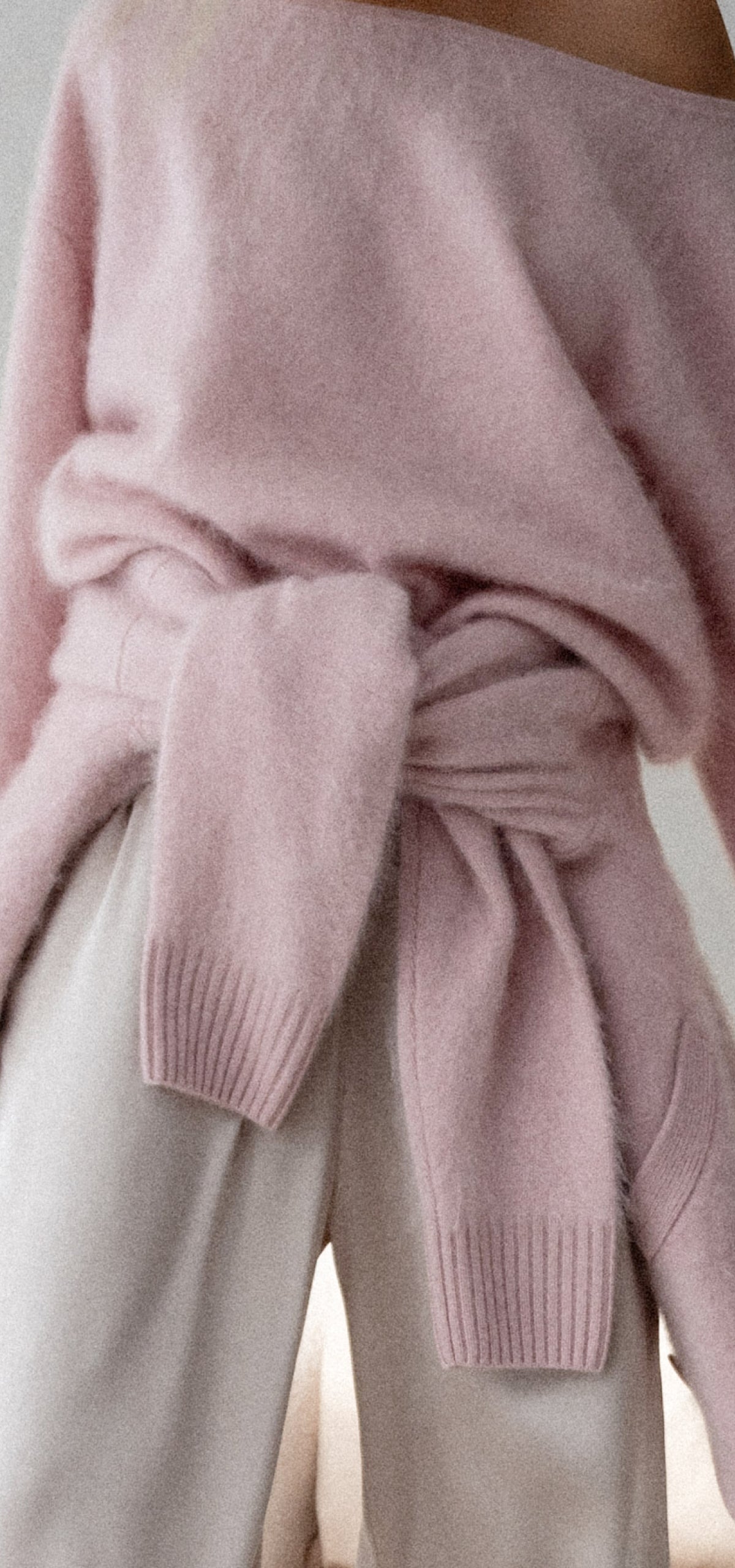Six Facts About Cashmere That Might Surprise You
Six Facts About Cashmere That Might Surprise You
Cashmere makes clothing an everlasting, worthy investment with its ability to maintain shape and color over decades. Just like precious metals, cashmere is considered a commodity yarn and is valued by its weight. Our main goal at NAKEDCASHMERE is to make beautiful cashmere styles that can last a lifetime. We love to share our cashmere knowledge with each customer, so they can make the best decisions when shopping for their quality NAKEDCASHMERE pieces. To help, we’ve put together six interesting facts about cashmere that we believe everyone should know
1
Cashmere can only be sourced from the undercoat of a special breed of goat
The goats used to harvest cashmere originated in Kashmir and are the only source for this fiber to this day. While populating both Pakistan and India, the hardiest of goats reside in Inner Mongolia, where the harsher climate encourages a thicker undercoat providing the best quality fibers.
2
Harvesting cashmere fibers can only happen during spring each year
Harvesting goat hairs is a yearlong process. For most of the year, goats live freely in the mountains of India, Pakistan and Mongolia and can only be combed in the springtime each year. This timeline allows for a full year of hair growth that is then combed from the goats before they have a chance to naturally shed. Once the “guard hair,” as it is called, has been combed and sorted by hand, the fiber undergoes a mechanical process to separate the actual cashmere strand used in garments.
Shop Faye Cardi
3
It takes 3-5 goats to make one sweater
In addition to the time limitations of sourcing cashmere, the quantity required to make one sweater adds to the cost of producing garments. While the male goats typically produce more cashmere than the females, one goat will yield only about 3-4 ounces of fibers per combing. It takes about 4 years for a single goat to produce enough fibers for one sweater!
4
Cashmere fiber is up to 6 times finer than human hair
The average diameter of a cashmere strand is no more than 19 microns. By comparison, a human hair can range from 17-181 microns in diameter. Not only is cashmere 8 times warmer than normal wool, but it is also considered to be that many times softer too. It is currently considered one of the most expensive natural materials on the market today. The quality of each strand is determined by length, diameter and ‘crimping’, a feature that gives the yarn loft, allowing for greater warmth to weight ratio than normal wool.
Shop Faye Cardi
5
Cashmere is hygroscopic.
This essentially means cashmere absorbs water from the air. It’s naturally moisture wicking, helping the body to regulate both warm and cool temperatures by absorbing and releasing moisture based on surrounding environment. This makes for a perfect year-round yarn!
6
Believe it or not, cashmere gets even softer with time!
With the right love and care, cashmere can actually get even softer with use. It’s generally recommended that unless there are visible stains, in which case dry cleaning is best, you should wash your cashmere product by hand. Cold water and a bit of baby shampoo gives your garment a little extra lushness when washing. Don’t feel the need to wash your garment after every use, either! Giving it a gentle wash after every 3+ uses is usually enough, especially if you are wearing layering pieces. Another great option is to air it our between uses to keep everything feeling and smelling fresh.
1
Cashmere can only be sourced from the undercoat of a special breed of goat
The goats used to harvest cashmere originated in Kashmir and are the only source for this fiber to this day. While populating both Pakistan and India, the hardiest of goats reside in Inner Mongolia, where the harsher climate encourages a thicker undercoat providing the best quality fibers.
2
Harvesting cashmere fibers can only happen during spring each year
Harvesting goat hairs is a yearlong process. For most of the year, goats live freely in the mountains of India, Pakistan and Mongolia and can only be combed in the springtime each year. This timeline allows for a full year of hair growth that is then combed from the goats before they have a chance to naturally shed. Once the “guard hair,” as it is called, has been combed and sorted by hand, the fiber undergoes a mechanical process to separate the actual cashmere strand used in garments.
Shop Faye Cardi
3
It takes 3-5 goats to make one sweater
In addition to the time limitations of sourcing cashmere, the quantity required to make one sweater adds to the cost of producing garments. While the male goats typically produce more cashmere than the females, one goat will yield only about 3-4 ounces of fibers per combing. It takes about 4 years for a single goat to produce enough fibers for one sweater!
4
Cashmere fiber is up to 6 times finer than human hair
The average diameter of a cashmere strand is no more than 19 microns. By comparison, a human hair can range from 17-181 microns in diameter. Not only is cashmere 8 times warmer than normal wool, but it is also considered to be that many times softer too. It is currently considered one of the most expensive natural materials on the market today. The quality of each strand is determined by length, diameter and ‘crimping’, a feature that gives the yarn loft, allowing for greater warmth to weight ratio than normal wool.
Shop Faye Cardi
5
Cashmere is hygroscopic
This essentially means cashmere absorbs water from the air. It’s naturally moisture wicking, helping the body to regulate both warm and cool temperatures by absorbing and releasing moisture based on surrounding environment. This makes for a perfect year-round yarn!
6
Believe it or not, cashmere gets even softer with time!
With the right love and care, cashmere can actually get even softer with use. It’s generally recommended that unless there are visible stains, in which case dry cleaning is best, you should wash your cashmere product by hand. Cold water and a bit of baby shampoo gives your garment a little extra lushness when washing. Don’t feel the need to wash your garment after every use, either! Giving it a gentle wash after every 3+ uses is usually enough, especially if you are wearing layering pieces. Another great option is to air it our between uses to keep everything feeling and smelling fresh.
1
Cashmere can only be sourced from the undercoat of a special breed of goat
The goats used to harvest cashmere originated in Kashmir and are the only source for this fiber to this day. While populating both Pakistan and India, the hardiest of goats reside in Inner Mongolia, where the harsher climate encourages a thicker undercoat providing the best quality fibers.
2
Harvesting cashmere fibers can only happen during spring each year
Harvesting goat hairs is a yearlong process. For most of the year, goats live freely in the mountains of India, Pakistan and Mongolia and can only be combed in the springtime each year. This timeline allows for a full year of hair growth that is then combed from the goats before they have a chance to naturally shed. Once the “guard hair,” as it is called, has been combed and sorted by hand, the fiber undergoes a mechanical process to separate the actual cashmere strand used in garments.
3
It takes 3-5 goats to make one sweater
In addition to the time limitations of sourcing cashmere, the quantity required to make one sweater adds to the cost of producing garments. While the male goats typically produce more cashmere than the females, one goat will yield only about 3-4 ounces of fibers per combing. It takes about 4 years for a single goat to produce enough fibers for one sweater!
4
Cashmere fiber is up to 6 times finer than human hair
The average diameter of a cashmere strand is no more than 19 microns. By comparison, a human hair can range from 17-181 microns in diameter. Not only is cashmere 8 times warmer than normal wool, but it is also considered to be that many times softer too. It is currently considered one of the most expensive natural materials on the market today. The quality of each strand is determined by length, diameter and ‘crimping’, a feature that gives the yarn loft, allowing for greater warmth to weight ratio than normal wool.
5
Cashmere is hygroscopic.
This essentially means cashmere absorbs water from the air. It’s naturally moisture wicking, helping the body to regulate both warm and cool temperatures by absorbing and releasing moisture based on surrounding environment. This makes for a perfect year-round yarn!
6
Believe it or not, cashmere gets even softer with time!
With the right love and care, cashmere can actually get even softer with use. It’s generally recommended that unless there are visible stains, in which case dry cleaning is best, you should wash your cashmere product by hand. Cold water and a bit of baby shampoo gives your garment a little extra lushness when washing. Don’t feel the need to wash your garment after every use, either! Giving it a gentle wash after every 3+ uses is usually enough, especially if you are wearing layering pieces. Another great option is to air it our between uses to keep everything feeling and smelling fresh.











